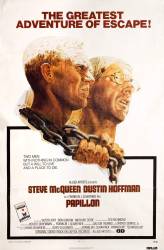Continuity mistake: In the scene where the inmate is being beheaded in the courtyard, as they change shots for the special effect you can now see that the sun has moved and is glaring into the camera lens and the executioner is now visible standing next to the guillotine.
Continuity mistake: Just after Papillon tattoos the butterfly on the native, he walks away with a considerable amount of sweat on the back of his shirt. A shot or two later, as he is walking toward the hut, most of the sweat has disappeared.
Continuity mistake: When Papillon is getting shaved by Maturette, the amount of foam on his face changes between shots.
Continuity mistake: When Papillion is running from the natives, he is unshaven. When he wakes up with the pearl divers, he's completely shaven.
Continuity mistake: When the inmates are trying to catch the butterflies, Papi is seen with his chest exposed, no tattoo on his chest. In the following scenes the butterfly tattoo is there.






Answer: It does appear to be unintentional (or at least, unscripted), but they continue because when you're shooting a movie, you don't stop until you hear "cut", and especially at that time animal welfare wasn't necessarily a priority. I'm guessing no-one was concerned about the chicken, and so didn't feel the need to do anything about it. It's possible the film was made without an animal welfare monitor on set. As to why it's in the movie, the whole "marching to the prison" sequence was probably handled by the assistant director (as shots like this, not involving the principals or any substantive dialogue, often are) and they may have only done the one take. Who knows, they may have thought the injured chicken added realism to the scene.